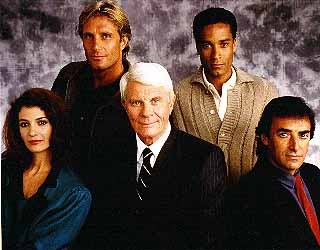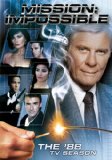| Reviews & Columns |
|
Reviews DVD TV on DVD Blu-ray 4K UHD International DVDs In Theaters Reviews by Studio Video Games Features Collector Series DVDs Easter Egg Database Interviews DVD Talk Radio Feature Articles Columns Anime Talk DVD Savant Horror DVDs The M.O.D. Squad Art House HD Talk Silent DVD
|
DVD Talk Forum |
|
|
| Resources |
|
DVD Price Search Customer Service #'s RCE Info Links |
|
Columns
|
|
|
Mission: Impossible - The '88 TV Season
The longest strike in the history of the Writers Guild of America (WGA) lasted exactly five months, from March-August 1988. The strike occurred during that time of year when scripts for new and continuing television series are developed, written, and polished, so the strike effectively delayed the start of the 1988-89 television season by several months. Some popular shows ended up getting cancelled because they lost so many viewers during the interim. Others made independent agreements with the WGA and were able to resume production a bit earlier. Some shows (notably Star Trek: The Next Generation) resorted to long-mothballed scripts and even built episodes around film clips from earlier episodes. So starved for new programming, a few producers found yet another means to create a "new" show while still adhering to limitations imposed by the strike.
The most innovative (or cheesiest) of these was a revival of Mission: Impossible. The idea was ingenious, if probably inspired by Universal's success with The New Alfred Hitchcock Presents a few seasons before: remake the old scripts, shows not seen in primetime for more than twenty years. Originally the idea was to go one step further, with new actors playing the original characters as well: Cinnamon Carter (Barbara Bain), Barney Collier (Greg Morris), Rollin Hand (Martin Landau), Willy Armitage (Peter Lupus) and, presumably, Dan Briggs (Steven Hill) rather than Jim Phelps (Peter Graves) because Mission: Impossible's first season shows (starring Hill) hadn't been widely seen since the '60s. However, once Graves agreed to return as Phelps, the decision was made to rename the other characters, though their functions are pretty much the same as before.
Probably because initially they were working from these tried-and-true older scripts (in some cases by unhappy writers who had their names removed from the credits), the revived Mission: Impossible turned out much better than anyone might reasonably have expected. It plays very much like a continuation of the original series, almost as if Mission: Impossible had never been cancelled at all, as if this was that show's 22nd season instead of the first season of an entirely new program.
But, for two reasons described below, the new Mission: Impossible is undermined somewhat by the manner in which it was produced, and this in turn has dated it even more than the original '60s-'70s series. CBS/Paramount's Mission: Impossible - The '88 TV Season is a five-disc set featuring all 19 first season episodes, which look nice, considering, though the packaging notes that some "music has been changed for this home entertainment version." No extras.
At the beginning of the first episode, the protégé of retired IMF agent Jim Phelps (Peter Graves) is murdered by a cold-blooded assassin (John de Lancie, who as "Q" also appeared in Star Trek: The Next Generation's first episode). Pressed back into service, Phelps assembles a new team including Nicholas Black (Thaao Penghlis), a Rollin Hand-type; Cinnamon-esque Casey Randall (Terry Markwell), who coincidentally shares the same name as Lynda Day George's Mission: Impossible character; Max Harte (Antony Hamilton), filling the Willy Armitage/muscle role; and Grant Collier, son of the original show's Barney, and played by actor Greg Morris's real-life son, Phil Morris. Halfway through the season Jane Badler's Shannon Reed replaces Markwell's Casey Randall.
Even the original voice sending Phelps on his weekly missions (should he choose to accept them) is back. Bob Johnson probably did more Mission: Impossibles than any other actor even though almost know one knows his name. Johnson died in 1993.
This being the late-1980s, the disembodied voice no longer emanates from a teeny reel-to-reel tape recorder, but rather comes from a minidisk activated by Phelps's identifying thumbprint. Indeed, generally speaking the series reflects the influence of 007 as much as the original show, with more futuristic gizmos and less simple cleverness.
The new series isn't bad. The use of original scripts got it off to a good start, and once the strike ended producers immediately began commissioning original teleplays. The new cast members aren't nearly as memorable as Bain, Landau, and even Peter Lupus, but they're entirely serviceable, certainly no worse than the original show's later cast members. And it's fun to see white-haired, leather-faced Peter Graves back on the job.
The show was made on the cheap, probably on the assumption that it could be easily discarded the minute the strike had ended. To save money it was shot in Queensland, Australia, though the episodes I watched unconvincingly try to pass off Queensland's cities as London and other European, American, and Asian locales. The original series stuck mostly to Desilu's and Paramount's backlots, though later shows, changing with the times, went out onto the streets of Los Angeles much more frequently, and even ventured to San Francisco for some shows. The Australian locales aren't bad, but they do give the new Mission: Impossible an off-kilter feel.
The far-flung location, at least for working actors based in Hollywood, may also have precluded the use of bigger-name guest stars, but Greg Morris reprises his Barney character in one episode, and Lynda Day George is back as Lisa Casey in another. A few other familiar faces appear: Shane Briant, Janis Paige, Parker Stevenson, James Shigeta, Cesare Danova, Nicholas Hammond, Barbara Luna, Michael Pate, Richard Romanus, Maud Adams, and Paula Kelly.
More damaging was the decision to shoot Mission: Impossible on 35mm film but then to do all the post-production work on videotape. Lots of American television shows from this period did this, again to save money, but it also made the shows look much chintzier than they actually were. The resultant image is harsh and soft at the same time, like a bad cable reception, and now causes endless headaches for studios wanting to distribute these shows in today's high-definition age. To make these shows presentable in high-definition, they'd have to go back to the original, unedited raw footage, assuming that's been stored away and not thrown out. In most cases, the high-cost of essentially redoing the entire postproduction of every episode isn't worth it, though Paramount seems pretty committed to restoring the three '80s-2000s Star Trek series, perennial cash cows that they are.
Just as the concurrent Star Trek: The Next Generation surprised many (in its early seasons) with contrastingly strong characterizations and weak stories, the opposite of what many had expected, the new Mission: Impossible offers much the same: the characters and their relationship are unexpectedly interesting but the plots of the later-season, newly-written scripts are weak compared to the marvelous puzzles of the original.
Video & Audio
Mission: Impossible - The '88 TV Season consists of 19 episodes running 48-49 minutes apiece, spread over five single-sided, dual-layered discs. Considering they were finished on videotape, the shows look about as good as they're going to get, which is decent by those standards but weak compared to shows finished on 35mm. The English stereo audio is pretty impressive, considering, though as mentioned earlier some background music has been altered for this release. SDH are offered and the disc is region 1 encoded. No Extra Features.
Parting Thoughts
I was expecting something pretty dire, but Mission: Impossible - The '88 TV Season ain't half-bad. Some episodes are quite superior to the original series' later seasons, though none approach the Hill-Graves-Landau-Bain years. Still, it's Recommended.
* I'm especially looking forward to the next one, Mission Impossible: The Quickening.
Stuart Galbraith IV's latest audio commentary is Godzilla vs. Megalon (with Steve Ryfle) or, as we like to call it, Release: Impossible.
|
| Popular Reviews |
| Sponsored Links |
|
|
| Sponsored Links |
|
|
| Release List | Reviews | Shop | Newsletter | Forum | DVD Giveaways | Blu-Ray | Advertise |
|
Copyright 2024 DVDTalk.com All Rights Reserved. Legal Info, Privacy Policy, Terms of Use,
Manage Preferences,
Your Privacy Choices | |||||||














